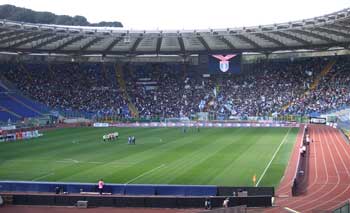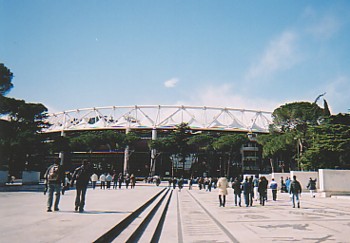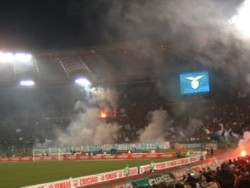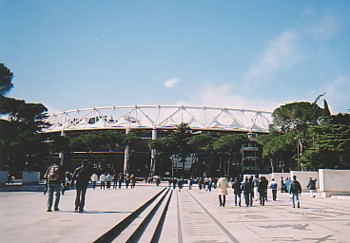Rome is a passionate footballing city and seeing a football match is a great way to experience the real Italy.
SS Lazio, AS Roma and the fans
 Lazio and Roma are the two principal football teams of Rome. They both have large local followings – dividing the city in two – and play in Serie A, Italy’s top division. The two teams share the Stadio Olimpico and alternate its use so Lazio will play a game there one weekend, and Roma the next. The derby matches between the two teams are hugely important, with an electric atmosphere which spreads through the whole city. Each team’s fans are fiercely partisan and tell unpleasant tales about the opposition but despite each of them claiming to be the ‘authentic’ Roman team, the truth is that both sets of fans are equally representative of local culture. Off the pitch and away from the rhetoric, Lazio and Roma supporters live and work side-by-side enjoying teasing and banter based around the teams’ relative Serie A positions.
Lazio and Roma are the two principal football teams of Rome. They both have large local followings – dividing the city in two – and play in Serie A, Italy’s top division. The two teams share the Stadio Olimpico and alternate its use so Lazio will play a game there one weekend, and Roma the next. The derby matches between the two teams are hugely important, with an electric atmosphere which spreads through the whole city. Each team’s fans are fiercely partisan and tell unpleasant tales about the opposition but despite each of them claiming to be the ‘authentic’ Roman team, the truth is that both sets of fans are equally representative of local culture. Off the pitch and away from the rhetoric, Lazio and Roma supporters live and work side-by-side enjoying teasing and banter based around the teams’ relative Serie A positions.
Stadio Olimpico
The Stadio Olimpico (‘Olympic Stadium’) is located by the banks of the River Tiber, a short way to the north of central Rome. It seats approximately 70,000 spectators. The stands, which curve right around the pitch, are covered, and are irritatingly divided from the pitch by a wide running track. The stadium was originally uncovered; the roof was added for the 1990 World Cup. New seating and security barriers were installed for the UEFA Champions’ League Final in 2009.

The stadium is situated in the Foro Italico, a big 1930s sporting complex glorifying Italy’s imperial past and its then ruler Mussolini’s own imperial ambitions. It’s really worth exploring on a non-match day for some interesting photographs and a taste of Rome’s more recent history (like the modernist EUR suburb to the south of Rome). Close to the Stadio Olimpico you’ll find Roman-style mosaics, an arena surrounded by statues of athletes and an obelisk emblazoned with the name Mussolini. His nickname Duce is repeated in the mosaic flooring. Interestingly, overseas journalists write sniffily about Italy, and Italian football’s flirtations with the right-wing, but are rarely aware of how the memories of Italian Fascism are still alive and woven into the country’s fabric in this concrete fashion.
Buying Serie A match tickets
You can buy tickets in advance for Serie A matches from various lottery outlets throughout Rome. Look out for signs advertising biglietti, calcio, Serie A, SS Lazio, AS Roma. The website of each club should provide an up-to-date list of tickets sales points (ricevitorie). You must take formal ID such as a passport for yourself and for each person for whom you are buying a ticket. Your name and ID details will be on the ticket and these will be checked at the stadium. It is also usually possible to buy tickets online – again, you should visit the clubs’ websites for the latest links, as ticket-selling arrangements change quite frequently.
Get to the stadium
The easiest way to reach the Stadio Olimpico from central Rome is to take tram number 2 from Piazzale Flaminio. The tram stops are just outside Piazza del Popolo (through the grand archway and across the road) and around the corner from Flaminio Metro station. Stay on the tram until its terminus in Piazza Mancini, which is around fifteen minutes away (return to the same stop to take the waiting trams after the match). At this point you should be able to follow the crowds of fans flooding from the bus and tram stops towards the stadium. From the tram stop you cross the bus stop area heading left. Take the wide footpath heading through the edge of the small park towards the main road which runs along the river. Cross the bridge over the Tiber, and you’ll see the Olimpico in front of you. The stadium lies directly ahead, past the obelisk dedicated to Mussolini. You’ll be approaching from the south-eastern corner, by the Distinti Est. The Curva Sud is to your left and the Tribuna Tevere is to the right. Security barriers now impede progress around the stadium, but signs should indicate you to your seating area.
To reach the stadium you must pass through large automatic turnstiles. You hold your ticket barcode under a scanner and the gates will let you through. There are stewards to help and advise. You will also need to show your passport as ID, and to have your bag searched.
Safety and behaviour

Visitors from other countries might be taken aback by the heavy police presence and the sometimes antagonistic behaviour of security forces. Although there are now a few stewards in the stadium and more at the entrances, the two end stands in particular (the Curva Sud for Roma fans and the Curva Nord for Lazio fans) are still no-go areas for the police and are ruled by the powerful factions of extreme fans. Trouble is not terribly common but it does happen, although unwilling participants are rarely caught up in violence. Tourists visiting a match will be most comfortable – and get the best view – from the Tribuna Tevere, running along the side of the stadium closest to the river. Around the exterior of the stadium, be alert to what is going on around you – get into the stadium and then away at the end quickly if you sense an ‘atmosphere’. If police are confronting troublemakers, they may use tear-gas, which can spread a long way in the air. Cover your nose and mouth and get away as quickly as you can.
Italians do not have a binge-drinking culture, and they don’t get drunk at football matches. You will offend local people by parading the streets drunkenly, and you may attract hostility from the police and other fans if you are visibly drunk. Although Italians love their teams, and hate their city opposition, they are used to living together and very rarely indulge in the kind of aggressive swaggering and shouting outside the stadium that I’ve seen from visiting British fans. They will, however, sing their hearts out inside the stadium, or ride through Rome hooting their scooters and waving flags happily to celebrate a derby victory.
Visiting the Stadio Olimpico for a football match is a great way to spend an afternoon or evening, and at a big match you’ll encounter an incredible, electric atmosphere. Be prepared, have an idea of what to expect, stay alert and sober, and enjoy the game.
On this site
Useful external links
Serie A (with match calendar)
